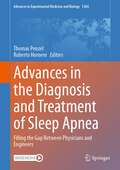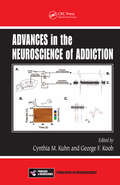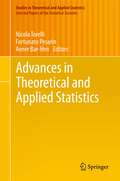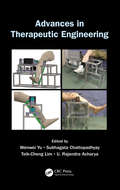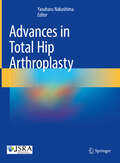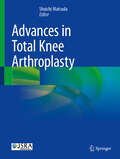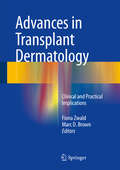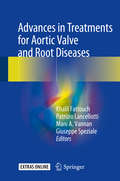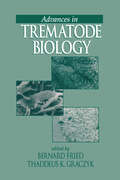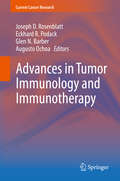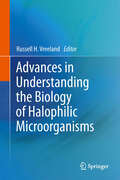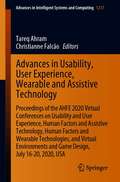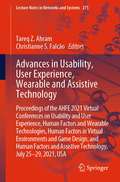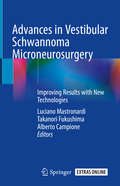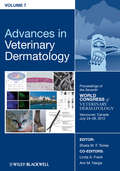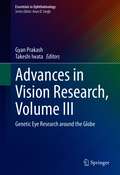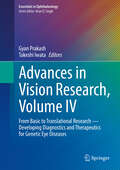- Table View
- List View
Advances in the Diagnosis and Treatment of Sleep Apnea: Filling the Gap Between Physicians and Engineers (Advances in Experimental Medicine and Biology #1384)
by Thomas Penzel Roberto HorneroThe book focuses on biomedical innovations related to the diagnosis and treatment of sleep apnea. The latest diagnostic tools are described, including sleep laboratory equipment, wearables, and even smartphone apps. Innovative medical devices for treatment are also covered, such as CPAP, Auto-PAP, hypoglossal nerve stimulation, phrenic nerve stimulation, acoustic brain stimulation and electrical brain stimulation. This is an ideal book for biomedical engineers, pneumologists, neurologists, cardiologists, physiologists, ENT physicians, pediatrics, and epidemiologists who are interested in learning about the latest technologies in treating and diagnosing sleep apnea.
Advances in the Neuroscience of Addiction (Frontiers in Neuroscience)
by Cynthia M. Kuhn George F. KoobUnderstanding the phenomenon of long-lasting vulnerability to addiction is essential to developing successful treatments. Written by an international team of authorities in their respective fields, Advances in the Neuroscience of Addiction provides an excellent overview of the available and emerging approaches used to investigate the biologic mechanisms of drug addiction. It also delineates the promising research discoveries being made in relapse prevention.The book begins with current animal models of addiction, which mimic the state of humans entering treatment: recently-abstinent animals that receive common triggers for relapse (classical conditioning, stress, and neuroadaptive dysregulation). Coverage then shifts to the use of electrophysiologic approaches, which enable researchers to characterize the discharge patterns of single neurons during drug self-administration. After exploring advances in voltammetry and enzyme-linked biosensors for measuring glutamate, the book discusses the theoretical background and results of neuroimaging studies related to neuronal networks that are activated by drug-specific cues. It then describes modern genetic approaches to manipulate target proteins that influence addictive behavior.The book rounds out its coverage by illustrating how a neuroeconomic approach can inform studies of reward processing in general and addiction in particular. It is a comprehensive introduction to the methodologies of the field for students and beginning researchers and an essential reference source for established investigators.
Advances in Theoretical and Applied Statistics (Studies in Theoretical and Applied Statistics)
by Fortunato Pesarin Avner Bar-Hen Nicola TorelliThis volume includes contributions selected after a double blind review process and presented as a preliminary version at the 45th Meeting of the Italian Statistical Society. The papers provide significant and innovative original contributions and cover a broad range of topics including: statistical theory; methods for time series and spatial data; statistical modeling and data analysis; survey methodology and official statistics; analysis of social, demographic and health data; and economic statistics and econometrics.
Advances in Therapeutic Engineering
by Wenwei Yu Subhagata Chattopadhyay Teik-Cheng Lim U. Rajendra AcharyaTherapeutic Engineering (TE) is a cutting-edge domain in today's era of medical technology research. Through engineering algorithms that provide technological solutions, it aims to elevate the quality of life of disabled individuals. Advances in Therapeutic Engineering describes various therapeutic processes and mechanisms currently applied to the
Advances in TNF Family Research: Proceedings of the 12th International TNF Conference, 2009 (Advances in Experimental Medicine and Biology #691)
by Andrew Kovalenko David Wallach Marc FeldmannThe biennial TNF-family conferences have been held over the past 20 years, from the time that TNF was cloned. These meetings have followed the enormous progress in this field. Much is now known about the members of the TNF ligand and receptor families, their signaling proteins, mechanisms of action and cellular functions. This volume is the proceedings of the 12th TNF International Conference, held in April 2009. This conference focuses on the physiological, pathophysiological, and medical significance of these important regulators. Sessions at the meeting specifically address their involvement in immunity, development, apoptosis, autoimmunity, cancer, and infection, the normal function and pathology of the neuronal system, as well as major unresolved questions about their mechanisms of action.
Advances in Total Hip Arthroplasty
by Yasuharu NakashimaThis book provides comprehensive, evidence-based surgical principles and techniques for total hip arthroplasty (THA), covering all aspects of this procedure, including the history, biomaterials, biomechanics, surgical techniques and other important issues. Beginning with an overview of the hip joint and its anatomy, the authors detail the biomechanics of the hip joint in its various states and further discuss the properties of biomaterials in arthroplasty. The book describes the principles of surgical technique, preoperative planning, surgical procedures, rehabilitation, and management of complications, and thoroughly illustrates surgical procedures to enhance the reader's understanding. The book also introduces the technical aspects of the procedure, including how to deal with difficult cases such as severely deformed cases and how to increase the safe range of motion. Advances in Total Hip Arthroplasty is written by a pioneering team of authors in cooperation with the Japanese Society for Replacement Arthroplasty (JSRA). The book is informative and provides practical tips for THA and academic insights for orthopedic surgeons and residents specializing in arthroplasty. The translation was done with the help of an artificial intelligence machine translation tool. A subsequent human revision was done primarily in terms of content.
Advances in Total Knee Arthroplasty
by Shuichi MatsudaThis book describes in full detail the surgical principles and technology of Total Knee Arthroplasty (TKA), providing evidence-based data on the biomechanics of the knee joint and biomaterials in arthroplasty. Starting the chapters with the history and anatomy, the book expands its focus on important issues such as implant designs of articular geometry and ligament substitution. It describes the thorough procedures of surgery from planning, operation, discussion on how to improve the range of motion, postoperative rehabilitation and also patient satisfaction. In chapters describing the surgical procedures, and approaches, step-by-step surgical techniques are shown to manage various severe deformities. Also, the clinical relevance of surgical techniques including soft tissue balancing and alignment of the components and computer-simulated studies are of importance to highlight. Advances in Total Knee Arthroplasty invite authors who are surgeons who have extensive experience in severely deformed joints. This book is collaborated with the Japanese Replacement Arthroplasty Society (JSRA), and it is an informative material for collecting academic insights for arthroplasty surgeons and orthopaedic residents. The translation was done with the help of artificial intelligence. Subsequently, human revisions were made, mainly in terms of content. Subsequently, stylistic revisions were made by a specialized copy editor.
Advances in Toxicology and Risk Assessment of Nanomaterials and Emerging Contaminants
by Liang-Hong Guo Monika MortimerThis book details the state-of-the-art methodological advances for delineating the toxicology and working mechanisms of nanomaterials, microplastics, fine aerosol particulates (PM2.5) as well as emerging organic pollutants. It also provides latest computational approaches for toxicity prediction and risk assessment of nanoscale materials which possess realistic chances to enter the environment and human organism. Written by leading scientists at the frontiers of environmental science and nanomedicine, this book is intended for both young researchers and experienced professionals working in the fields of environmental protection, human health and occupational safety, nanotechnology, material science and nanomedicine, as well as graduate students majoring in environmental and health sciences.
Advances in Translational Neuroscience of Eye Movement Disorders (Contemporary Clinical Neuroscience)
by Aasef Shaikh Fatema GhasiaA comprehensive book that reviews advances in ocular motor research on topics of general interest, rare, specialized or unique conditions, and pertinent basic neuroscience. A rare collection with contributions from basic neuroscientists, neurologists, and ophthalmologists. Includes dedicated chapters on mathematical models, pharmacotherapy, neuromodulation, motion perception, visual influence on eye movement, physiology of strabismus, and microsaccades. This book is dedicated to David Robinson - one of the pioneers of contemporary ocular motor and vestibular neuroscience.
Advances in Transplant Dermatology: Clinical and Practical Implications
by Fiona Zwald Marc D. BrownThis book provides an informative update on scientific advances relating to transplant dermatology that may be applicable to clinical practice. Commentary is provided on the emerging role of viruses in transplant dermatology, the management of skin disease secondary to transplant medication, sunscreen use in transplant recipients, the role of revision of immunosuppression, and advances in photodynamic therapy. The latest staging and management criteria for high-risk squamous cell carcinoma and the implications for clinical practice are then analyzed. Finally, the management of other cutaneous malignancies is discussed, covering malignant melanoma, Merkel cell carcinoma, and rarer tumors that also behave aggressively and require special consideration in solid organ transplant patients. Each particular advance is addressed in an individual chapter by leaders in the field. The book both expands current knowledge and complements previous textbooks on the subject.
Advances in Treatments for Aortic Valve and Root Diseases
by Giuseppe Speziale Mani A. Vannan Patrizio Lancellotti Khalil FattouchThis book describes the different aspects of aortic valve and root diseases including comprehensive discussion of the state-of-the-art diagnostic imaging options, disease risk stratification, selection of candidates for valve repair or percutaneous intervention, and most recent therapeutic options. The growing prevalence of valvular heart disease represents a major challenge in terms of short- and long-term management and surveillance. Aortic valve diseases, including aortic stenosis and regurgitation, are among the most frequent of these, while the number of cases of aortic root disease is also on the rise. Aortic valve disease treatment options include valve surgery, valve repair, minimally invasive valve surgery, and percutaneous approaches and all are covered in this volume.
Advances in Trematode Biology
by Bernard Fried Thaddeus K. GraczykTrematodology - the study of a class of medically important parasitic, flat-bodied worms - has made significant advances over the past ten years. The tremendous amount of information accumulated from research discoveries and technical developments related to trematode biology makes this book a timely and necessary part of the literature. Advances in Trematode Biology presents a thorough treatment of modern trematodology, including principles and practices. With coverage of background material as well as modern methods, Advances in Trematode Biology updates researchers, practitioners, and students with new information in immunology, biochemistry, physiology, and molecular biology. Advances in Trematode Biology includes practical information on parasitological techniques, emphasizing species of medical and veterinary importance - a key reference for parasitologists, biologists, medical, and veterinary personnel. The excellent presentation of material, including well-organized tables and chapters, make Advances in Trematode Biology easy to use both as a textbook and as a reference.
Advances in Tumor Immunology and Immunotherapy (Current Cancer Research)
by Joseph D. Rosenblatt Eckhard R. Podack Glen N. Barber Augusto OchoaRecent advances in understanding of fundamental immunology have created new insights into the dynamic interactions between tumors and the immune system. This includes new understanding of T- and B-cell interaction, immune inhibitory mechanisms including the biology of T regulatory cells, myeloid suppressor cells, and dendritic cell subsets. Enhanced understanding of mechanisms underlying T-cell anergy such as arginine deprivation, immunosuppressive cytokines, defective innate and interferon response pathways, and NKG2D downregulation have all provided new insight into suppression of anti-tumor immunity and tumor evasion. In addition to emerging understanding of tumor evasion, new immune targets such as CTLA4 blockade, NK stimulatory receptors, manipulation of the antigen processing and presentation, cytokine and costimulatory responses all provide new possibilities for enhancing anti-tumor immunity even in tumors previously felt to be resistant to immune attack. Several of these strategies have already been realized in the clinic. The volume will explore evolving paradigms in antigen presentation, dendritic cell biology, the innate response and immunosuppressive mechanisms, and emerging strategies for manipulation of the immune system for therapeutic benefit that have realized success in neuroblastoma, leukemia, melanoma, lung cancer, and allogeneic transplantation. Early successes as well as failures will be highlighted to provide a snapshot of the state of clinical immunotherapy with an eye to future possibilities such as combination therapies, adoptive T-cell transfer, and the retargeting of immune cells via T-cell receptor engineering.
Advances in Understanding Kingella kingae (SpringerBriefs in Immunology)
by Joseph W. St. GemeThis book describes the growing body of information on the epidemiology, clinical manifestations, transmission, pathogenesis, diagnosis, and treatment of Kingella kingae infections in young children. In addition, it covers experimental methods that have been developed to study the microbiology, genetics, and virulence factors of K. kingae, information that provides the foundation for new approaches to treatment and prevention of K. kingae disease. With this content in mind, excerpts from the book will be of relevance for clinicians who care for pediatric patients, for clinical microbiologists who are involved in detecting organisms in clinical specimens, and for scientists who are studying K. kingae in an effort to develop novel targets for antimicrobial therapy and new approaches to prevention. First isolated in the 1960s by Elizabeth O. King, a bacteriologist at the CDC, Kingella kingae was largely ignored over the next two decades as a human pathogen because of its uncommon recovery from patients with disease. However, in recent years K. kingae has been increasingly recognized as a clinically important pathogen in young children, and is currently recognized as the leading cause of osteoarticular infections in young children in a growing number of countries. Research into this organism has grown tremendously over the past 15 years, resulting in a better appreciation of the importance of K. kingae in pediatric patients and of the molecular mechanisms of disease.
Advances in Understanding the Biology of Halophilic Microorganisms
by Russell H. VreelandThis book is designed to be a long term career reference. The chapters present modern procedures. This is a how-to-book with a difference. These chapters: - reveal the background information about working with salt loving organisms, - are loaded with information about how experiments are conducted under high salt, - provide information about analyses that work under these conditions and those that may not, - present a wide range of details from laboratory designs to equipment used and even to simple anecdotal hints that can only come from experience. Microbiological training focuses largely on the growth, the handling and the study of the microbes associated with humans and animals. Yet the largest proportion of the Earth's microbiota lives in saline environments such as the Oceans, saline deserts and terminal hypersaline environments. This need for salt can be intimidating for those interested in entering the field or for those interested in understanding how such research is accomplished.
Advances in Usability, User Experience, Wearable and Assistive Technology: Proceedings of the AHFE 2020 Virtual Conferences on Usability and User Experience, Human Factors and Assistive Technology, Human Factors and Wearable Technologies, and Virtual Environments and Game Design, July 16-20, 2020, USA (Advances in Intelligent Systems and Computing #1217)
by Tareq Ahram Christianne FalcãoThis book addresses emerging issues in usability, interface design, human–computer interaction, user experience and assistive technology. It highlights research aimed at understanding human interactions with products, services and systems and focuses on finding effective approaches for improving the user experience. It also discusses key issues in designing and providing assistive devices and services for individuals with disabilities or impairment, offering them support with mobility, communication, positioning, environmental control and daily living. The book covers modeling as well as innovative design concepts, with a special emphasis on user-centered design, and design for specific populations, particularly the elderly. Further topics include virtual reality, digital environments, gaming, heuristic evaluation and forms of device interface feedback (e.g. visual and haptic). Based on the AHFE 2020 Virtual Conference on Usability and User Experience, the AHFE 2020 Virtual Conference on Human Factors and Assistive Technology, the AHFE Virtual Conference on Human Factors and Wearable Technologies, and the AHFE 2020 Virtual Conference on Virtual Environments and Game Design, held on July 16–20, 2020, it provides academics and professionals with an extensive source of information and a timely guide to tools, applications and future challenges in these fields.
Advances in Usability, User Experience, Wearable and Assistive Technology: Proceedings of the AHFE 2021 Virtual Conferences on Usability and User Experience, Human Factors and Wearable Technologies, Human Factors in Virtual Environments and Game Design, and Human Factors and Assistive Technology, July 25-29, 2021, USA (Lecture Notes in Networks and Systems #275)
by Tareq Z. Ahram Christianne S. FalcãoThis book addresses emerging issues in usability, interface design, human–computer interaction, user experience and assistive technology. It highlights research aimed at understanding human interactions with products, services and systems and focuses on finding effective approaches for improving the user experience. It also discusses key issues in designing and providing assistive devices and services for individuals with disabilities or impairment, offering them support with mobility, communication, positioning, environmental control and daily living. The book covers modeling as well as innovative design concepts, with a special emphasis on user-centered design, and design for specific populations, particularly the elderly. Further topics include virtual reality, digital environments, gaming, heuristic evaluation and forms of device interface feedback (e.g. visual and haptic). Based on the AHFE 2021 Conferences on Usability and User Experience, Human Factors and Wearable Technologies, Human Factors in Virtual Environments and Game Design, and Human Factors and Assistive Technology, held virtually on 25–29 July, 2021, from USA, this book provides academics and professionals with an extensive source of information and a timely guide to tools, applications and future challenges in these fields.
Advances in Vagal Afferent Neurobiology (Frontiers in Neuroscience)
by Bradley J. Undem Daniel WeinreichTaking a comprehensive approach in which all aspects of the vagal afferent system are considered, this extensive text reviews the development, neurochemistry, anatomy, biophysics, pharmacology, and physiology of the vagal afferent nerves. The authors present experimental techniques used to investigate the development, morphology, electrophysiology and reflex function of the vagal afferent nerves, and include state-of-the-art reviews of vagal afferent neurobiology by some of the world's leading experts in these fields.
Advances in Vascular Medicine
by Michael Dashwood Gerry Coghlan Clive Handler David AbrahamThere are few books available focusing on translational science in vascular medicine, particularly in the developing field of molecular basis and clinical complications of vascular disease. Advances in Vascular Medicine contains state-of-the-art papers by world experts addressing the key frontier areas of vascular molecular and clinical medicine.
Advances in Vestibular Schwannoma Microneurosurgery: Improving Results With New Technologies
by Luciano Mastronardi Takanori Fukushima Alberto CampioneThis volume describes the most relevant and cutting-edge technological news on the complex surgical procedure of acoustic neuroma. The clinical-radiological diagnosis and surgical indications are briefly presented and the surgical technique is illustrated step-by-step: video clips show the latest means of treating these patients. All these indications were prepared by highly experienced experts in the field, based on their personal experience. The new technologies discussed concern e.g. the intraoperative identification and position of the facial nerve, hearing preservation, techniques for dural closure, and the usefulness of laser and ultrasound aspirators. The book also discusses a number of ongoing projects, including those on: diluted papaverine for microvascular protection of cranial nerves, flexible endoscope for IAC control of tumor removal, fluid cement for bone closure, administering aspirin to control residual tumors larger than 7mm, and DTI for preoperative prediction of the position of the facial nerve. This is a highly informative presented book providing surgeon interested in acoustic neuroma with necessary information on modern technologies available for improving the results of patients.
Advances in Veterinary Dermatology, Proceedings of the Seventh World Congress of Veterinary Dermatology, Vancouver, Canada, July 24-28, 2012
by Sheila M. Torres Linda Frank Ann HargisRepresenting the state of the art of veterinary dermatology around the globe, Advances in Veterinary Dermatology, Volume 7, presents selected scientific papers from the Seventh World Congress of Veterinary Dermatology. The Congress, held in Vancouver, Canada in July 2012, was organized with the support of the World Association for Veterinary Dermatology (WAVD) and its affiliated societies. A record number of delegates attended from over 50 countries to take advantage of the exceptional scientific program. Cutting edge information was presented as review papers and original studies in the areas of:AllergyImmunology Skin Biology TherapyInfectious DiseasesOncologyThese peer-reviewed and edited papers were published in the journal Veterinary Dermatology in volume 24, issue 1, and are included in this hardbound book volume of the conference proceedings. Also included are 13 Workshop Reports which summarise sessions where experts presented topics in various areas providing a wonderful opportunity for colleagues to ask questions and exchange ideas in an informal atmosphere.A vital resource for all practising veterinarians and researchers interested in the field of veterinary dermatology.
Advances in Vision Research, Volume I: Genetic Eye Research in Asia and the Pacific (Essentials in Ophthalmology)
by Gyan Prakash Takeshi IwataThis book presents the state of the art in genetic eye research in Asia and the Pacific. Though there has been an explosion of information on genetic eye research in western countries, more than sixty percent of the human genes involved in eye diseases in the Asian and Pacific population remain unknown. However, new efforts and a new awareness have sparked important discussions on the subject, and new plans are being implemented to discover the genes responsible for many eye diseases in the population. The book reviews the latest findings; its content ranges from genetic aspects of human migration to DNA sequence analysis, genome-wide association analysis, and disease phenotypes. The efforts of the Asian Eye Genetic Consortium (AEGC) are also discussed. The book's editors have been instrumental in developing strategies for discovering the new Asian genes involved in many eye diseases. All chapters were written by leading researchers working on Asian eye genetics from the fields of Human Genetics, Ophthalmology, Molecular Biology, Biochemistry, Sensory Sciences, and Clinical Research. Advances in Vision Research, Volume I will prove to be a major resource for all researchers, clinicians, clinical researchers, and allied eye health professionals with an interest in eye diseases among the Asian population.
Advances in Vision Research, Volume II: Genetic Eye Research In Asia And The Pacific (Essentials In Ophthalmology Ser.)
by Gyan Prakash Takeshi IwataThis second volume continues with a focus on the state of the art in genetic eye research in Asia and the Pacific. Though there has been an explosion of information on genetic eye research in western countries, more than sixty percent of the human genes involved in eye diseases in the Asian and Pacific population remain unknown. However, new efforts and a new awareness have sparked important discussions on the subject, and new plans are being implemented to discover the genes responsible for many eye diseases in the population. The book reviews the latest findings; its content ranges from genetic aspects of human migration to DNA sequence analysis, genome-wide association analysis, and disease phenotypes. The efforts of the Asian Eye Genetic Consortium (AEGC) are also discussed. The book’s editors have been instrumental in developing strategies for discovering the new Asian genes involved in many eye diseases. All chapters were written by leading researchers working on Asian eye genetics from the fields of Human Genetics, Ophthalmology, Molecular Biology, Biochemistry, Sensory Sciences, and Clinical Research. Advances in Vision Research, Volume II will prove to be a major resource for all researchers, clinicians, clinical researchers, and allied eye health professionals with an interest in eye diseases among the Asian population.
Advances in Vision Research, Volume III: Genetic Eye Research around the Globe (Essentials in Ophthalmology)
by Gyan Prakash Takeshi IwataThis third volume, with three supporting editors, broadens its focus on genetic eye research from the Asian to the global scale. New efforts and a new awareness have sparked important discussions on genetic eye research, and new plans are being implemented to identify the genes responsible for numerous eye diseases. The book introduces the latest findings on genetics in eye diseases, gene therapy, and genome-wide association analysis, and the efforts of the Global Eye Genetic Consortium (GEGC). The book’s editors have been instrumental in developing strategies for discovering the new genes involved in many eye diseases. All chapters were written by leading researchers working on eye genetics from the fields of Human Genetics, Ophthalmology, Molecular Biology, Biochemistry, Sensory Sciences, and Clinical Research. Advances in Vision Research, Volume III is a major resource for all researchers, clinicians, clinical researchers, and allied eye health professionals with an interest in eye diseases around the globe.
Advances in Vision Research, Volume IV: From Basic to Translational Research — Developing Diagnostics and Therapeutics for Genetic Eye Diseases (Essentials in Ophthalmology)
by Gyan Prakash Takeshi IwataThis fourth volume in the series Advances in Vision Research describes importance advancements in basics to translational research, including new therapeutics for genetic eye diseases. Recent US FDA approval of the first gene therapy for an inherited retinal disease, due to a mutation in the RPE65 gene, has led to an upsurge in translational eye research. The coverage in this volume includes corneal diseases, myopia, cataract, glaucoma, inherited retinal diseases, inherited optic neuropathy, and other genetic eye diseases. New developments such as the application of artificial intelligence in translational eye research are also discussed. All chapters are written by leading researchers working on eye genetics from the fields of Human Genetics, Ophthalmology, Molecular Biology, Biochemistry, Sensory Sciences, and Clinical Research. Advances in Vision Research, Volume IV will be a major resource for all researchers, clinicians, clinical researchers, andallied eye health professionals with an interest in eye diseases around the globe. The first two volumes in the series described the state of the art in genetic eye research in Asia and the Pacific while the third focused on progress in Europe and the United States.
